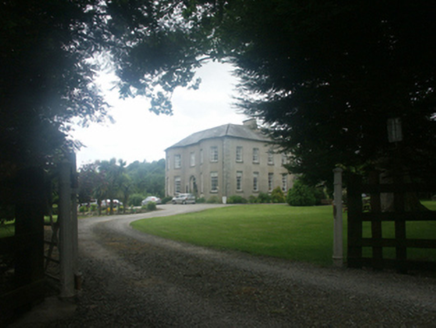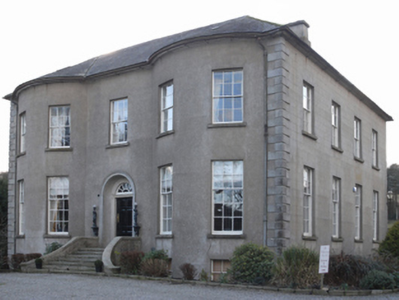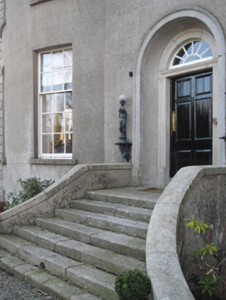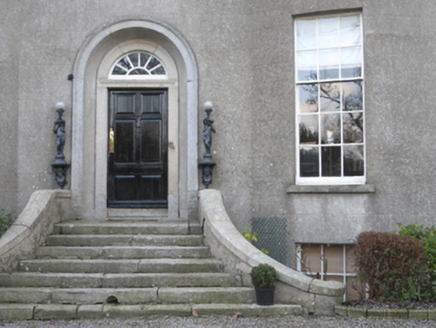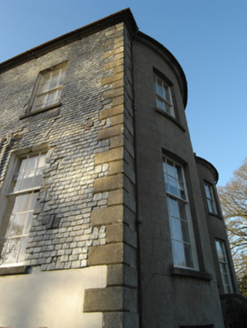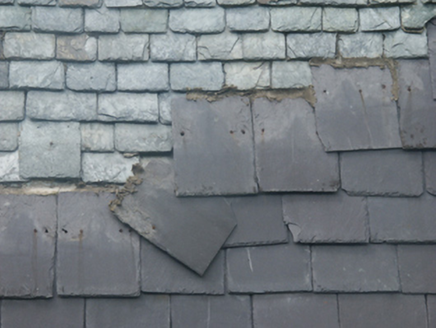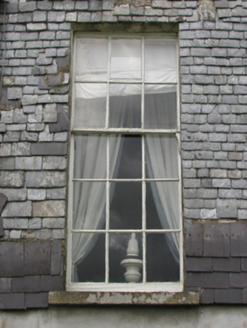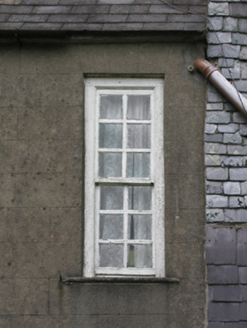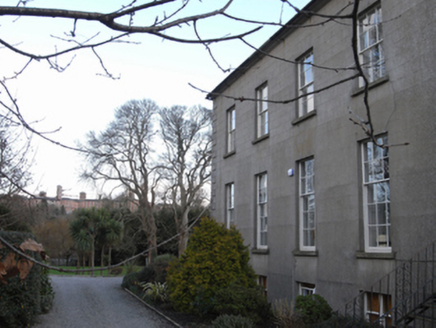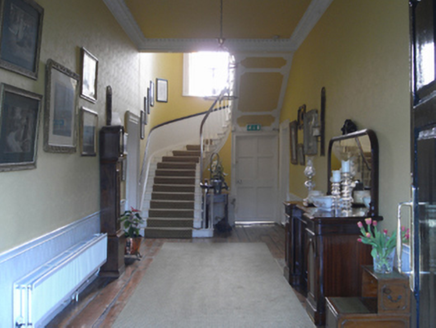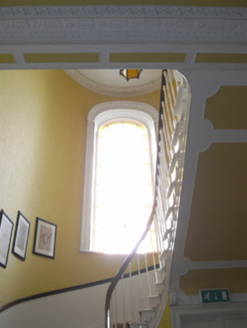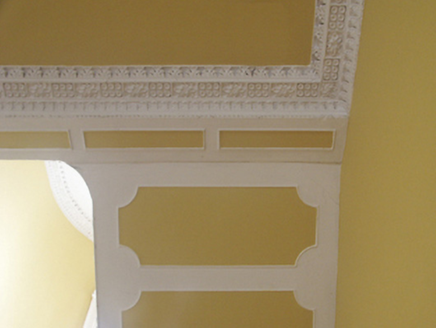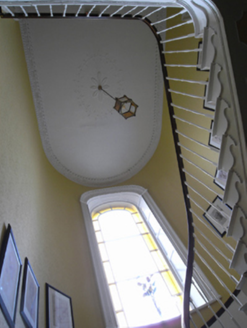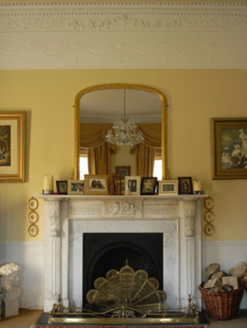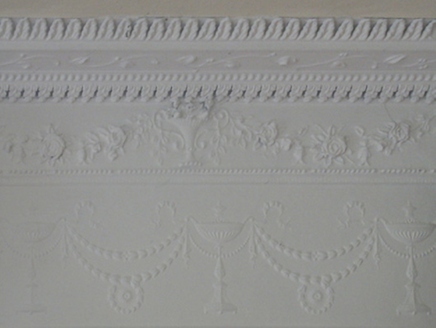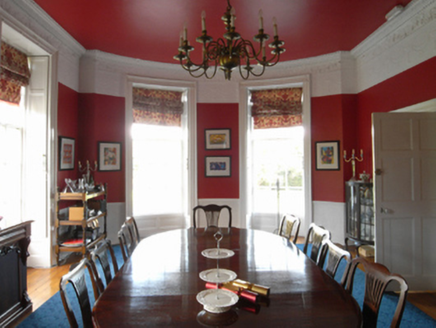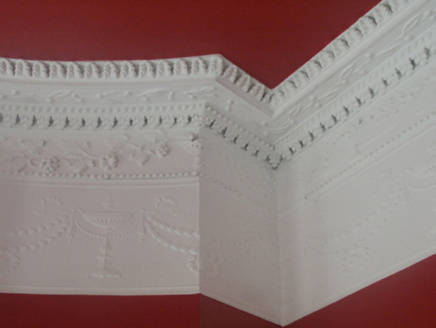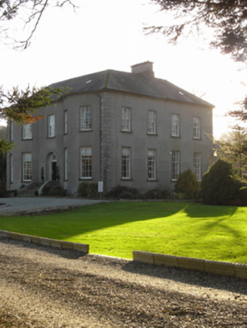Survey Data
Reg No
15604027
Rating
Regional
Categories of Special Interest
Archaeological, Architectural, Artistic, Historical, Social
Original Use
Country house
In Use As
Country house
Date
1805 - 1815
Coordinates
297153, 138190
Date Recorded
13/06/2005
Date Updated
--/--/--
Description
Detached three- or five-bay two-storey over part raised basement country house, built 1810, on a U-shaped plan with single- or two-bay full-height bows on segmental plans; three-bay (south) or four-bay (north) full-height side elevations. Sold, 1897. Occupied, 1901; 1911. Sold, 1940. Resold, 1983. Resold, 1993, to accommodate alternative use. Hipped slate roof on a quadrangular plan including half-conical slate roofs (east); clay ridge tiles, cement rendered chimney stacks on axis with ridge having concrete capping supporting terracotta or yellow terracotta pots, rooflights, and cast-iron rainwater goods on cut-granite "Cyma Recta" or "Cyma Reversa" cornice retaining cast-iron downpipes. Rendered, ruled and lined walls with rusticated cut-granite quoins to corners; slate hung surface finish to side (south) elevation on cement rendered base. Segmental-headed central door opening approached by flight of seven cut-granite steps with cut-granite surround framing timber panelled door having fanlight. Square-headed window openings with cut-granite sills, and concealed dressings framing three-over-three (basement), six-over-nine (ground floor) or six-over-six (first floor) timber sash windows without horns. Elliptical-headed central window opening to rear (west) elevation with cut-granite sill, and concealed dressings framing fixed-pane fitting having stained glass margins. Interior including (ground floor): bow-ended central hall retaining carved timber surrounds to door openings framing timber panelled doors, "Acanthus"-detailed decorative plasterwork cornice to ceiling centred on decorative plasterwork ceiling rose, staircase on a dog leg plan with turned timber "spindle" balusters supporting carved timber banister terminating in volute, carved timber Classical-style surround to window opening to half-landing framing timber panelled shutters, carved timber surrounds to door openings to landing framing timber panelled doors, and "Acanthus"-detailed decorative plasterwork cornice to ceiling centred on decorative plasterwork ceiling rose; bow-ended drawing room (south) retaining carved timber surround to door opening framing timber panelled door with carved timber surrounds to window openings framing timber panelled shutters, "Acanthus"-detailed cut-white marble Classical-style chimneypiece, and "Acanthus"-detailed decorative plasterwork cornice to ceiling on decorative plasterwork frieze centred on decorative plasterwork ceiling rose; bow-ended dining room (north) retaining carved timber surround to door opening framing timber panelled door with carved timber surrounds to window openings framing timber panelled shutters on panelled risers, cut-veined black marble Classical-style chimneypiece, and "Acanthus"-detailed decorative plasterwork cornice to ceiling on decorative plasterwork frieze centred on decorative plasterwork ceiling rose; and carved timber surrounds to door openings to remainder framing timber panelled doors with carved timber surrounds to window openings framing timber panelled shutters on panelled risers. Set in landscaped grounds.
Appraisal
A country house erected for Charles Hill JP (d. 1853; Lewis 1837 II, 30) representing an important component of the early nineteenth-century domestic built heritage of the rural environs of Enniscorthy with the architectural value of the composition, one not only refronting a 'faire stone house' owned (1641) by Sir Gerard Lowther (1589-1660) [SMR WX026-004002-] but also occupying the site of a monastery founded (1232) by Gerald de Prendergast (1187-c.1251) [SMR WX026-004001-], confirmed by such attributes as the deliberate alignment maximising on scenic vistas overlooking the River Slaney with its rolling backdrop; the symmetrical footprint centred on a restrained doorcase not only demonstrating good quality workmanship in a silver-grey granite, but also showing a simple radial fanlight; and the diminishing in scale of the openings on each floor producing a graduated visual impression with the principal "apartments" defined by curvilinear bows. Having been well maintained, the elementary form and massing survive intact together with substantial quantities of the original fabric, both to the exterior and to the interior including not only crown or cylinder glazing panels in hornless sash frames, but also a partial slate hung surface finish widely regarded as an increasingly endangered hallmark of the architectural heritage of County Wexford: meanwhile, contemporary joinery; Classical-style chimneypieces; and decorative plasterwork enrichments, all highlight the artistic potential of the composition. Furthermore, adjacent outbuildings (----) continue to contribute positively to the group and setting values of a self-contained estate having historic connections with the Hill family including Charles Henry Hill (d. 1871) 'late of Saint John's County Wexford' (Calendars of Wills and Administrations 1871, 261); and Reverend Hugh Robert Hill (d. 1880), 'Clerk late of Saint John's Enniscorthy County Wexford' (Calendars of Wills and Administrations 1880, 317); and the Kavanagh family including Edward Kavanagh (----), 'Farmer' (NA 1901; NA 1911).
